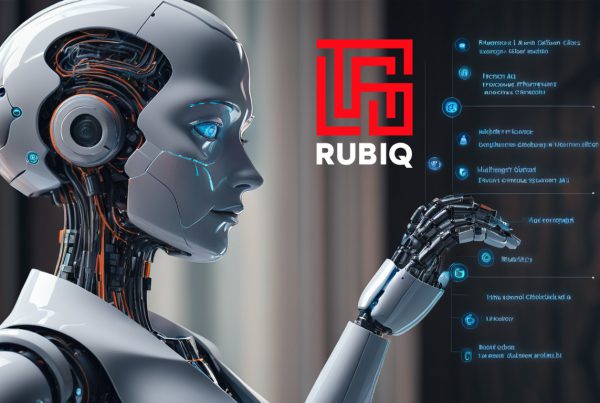The rise of cyber threats has become a significant global concern, affecting individuals, businesses, and governments. This increase in cyber threats can be attributed to several factors, including technological advancements, the growing interconnectedness of systems, and the evolving tactics of cybercriminals. Here’s an in-depth look at the key aspects contributing to the rise of cyber threats:
1. Advancement in Technology
Last month we touched on the impact AI is having in “business as usual” and briefly unpacked the key points addressed by the EU AI Act 2024. The rapid development of technology has brought both benefits and risks.
While new technologies like cloud computing, Internet of Things (IoT), and artificial intelligence (AI) have revolutionized industries, they have also introduced new vulnerabilities. As systems become more complex, the potential attack surface for cybercriminals expands. Yet the maturity in ITGRC remains at lower than desired levels. A recipe for imminent disaster.
2. Increased Connectivity
The proliferation of internet-connected devices, along with the rise of 5G, has led to an increasingly interconnected world. This connectivity, while beneficial for communication and commerce, also means that a breach in one system can have far-reaching consequences. IoT devices, in particular, often lack robust security measures, making them attractive targets for hackers.
3. Sophistication of Cyber Attacks
Cybercriminals are continuously developing more sophisticated attack methods. While many internal and 3rd party teams often have not evolved well enough and remain lost in the past. Advanced Persistent Threats (APTs), ransomware, phishing, and zero-day exploits are some examples of the evolving strategies used by attackers. These methods are becoming more difficult to detect and defend against, posing significant challenges to cybersecurity professionals and leave organizations vulnerable and exposed. Statistics indicate that the average cost to company, of a small to medium size business in South Africa, is around 5 million USD. Worst case, in excess of R50 million USD. There are not many businesses in today’s economic climate that can survive such a loss. Much of the loss impact often is in the softer issue of Reputational damages. Furthermore, many organizations are becoming slower at recovering form ransomware attacks, some taking as long as 6 months to over a year. The secondary costs of the impact are massive.
The average cost of a data breach, for a South African organization, sits at a hefty R49. 45 million. This is according to the 2023 Cost of a Data Breach Report, which came out February this year, which is research conducted by the Ponemon Institute and analysed and published by IBM Security.
4. Economic and Political Motivations
Crime pays!
Economic gain is a primary driver behind many cyber-attacks. Cybercriminals target businesses and individuals to steal sensitive data, financial information, and intellectual property. Additionally, state-sponsored actors engage in cyber espionage and sabotage for political and strategic advantages, leading to an increase in cyber warfare. As we have seen in recent events in the US, it is not only data that is being targeted, but criminals have the potential and may be starting to target critical physical infrastructure, as in the East Coast Francis Scott Key Bridge collapse, which happened in March this year. There has been much speculation that the control systems of the ship were remotely tampered with in a cyberattack. Be this event conspiracy theory or reality, the fact is that the interconnectedness of our world, lays out a very real scenario for physical infrastructure cyber-attacks that have the potential to hold cities and countries to ransom, through cyber warfare.
5. Lack of Cybersecurity Awareness
Despite the growing threat landscape, there is still a lack of adequate cybersecurity awareness among individuals and organizations. Many people are not knowledgeable about safe online practices, and organizations often do not invest enough in robust cybersecurity measures, making them vulnerable to attacks. People are the weakest link, and we so often see, through the maturity evaluations and cyber risk benchmarking we do, along with our advisory and consulting work, that there is just not enough invested into continuous training and awareness. The opportunity to effectively use transactional data based GRC techniques in this area, as we spoke about in our blog last month, can prove to be immensely valuable in supporting an ongoing people awareness program in your organization.
6. Globalization of Cybercrime
Cybercrime has become a global issue, with cybercriminals operating across borders. The anonymity provided by the internet allows attackers to operate from any location, making it difficult for law enforcement agencies to track and apprehend them. This globalization has led to the rise of sophisticated cybercrime networks that collaborate and share resources. Once of the requirements of a ISO 27001:2022 certification programme, is to connect with local and international forums and communities, for the purpose of staying up to date on the latest knowledge sharing within these communities. This has become a vital requirement for CISO to ensure that they are actively engaged in knowledge sharing across local and international communities to stay informed.
7. Inadequate Regulatory Measures
In many regions, cybersecurity regulations and standards are either insufficient or not rigorously enforced. This regulatory gap allows cybercriminals to exploit weaknesses in the legal and enforcement frameworks. Efforts to establish comprehensive cybersecurity laws and international cooperation are ongoing but remain a work in progress. The approach taken by the National Cyber Security Center is well worth implementing as a standard across all countries to standardize the minimum requirements that organizations to have and demonstrate evidence of keeping in place as a defense against cyber-attacks. An organization investing in an ISO 27001:2022 as a minimum certification, is no longer a nice to have but should be a critical strategic objective for every business.
8. Rise of Ransomware-as-a-Service (RaaS)
The emergence of Ransomware-as-a-Service (RaaS) has lowered the barrier to entry for cybercriminals. RaaS platforms allow even those with limited technical skills to launch ransomware attacks, leading to a surge in these types of incidents. This model has made ransomware a highly lucrative and popular method of attack. Much more needs to be done to combat this highly competitive and growing criminal market if we are to ensure our businesses sustainability and longevity.
Impact of Cyber Threats
The rise in cyber threats has profound implications. Financial losses from cybercrime are estimated to be in the trillions of dollars annually. Beyond the economic impact, cyber threats can lead to the loss of sensitive personal and business information, damage to reputation that is often almost impossible to really come back from, and disruption of critical infrastructure. For governments, cyber-attacks can undermine national security and public trust.
Mitigation and Response
Addressing the rise of cyber threats requires a multifaceted approach:
IT GRC Framework: The first step organizations need to be taking is investing in the development of a sound IT Governance Framework that specifies the roles and responsibilities throughout the organization in dealing with the cyber risks that the organization is facing. This framework must have a clearly defined Risk Process and Treatment of Risk Methodology that is context specific and relevant to improving the bottom line of the business. Lastly this Framework must include a robust Control Assurance and Attestation Framework, to mitigate risk and transparently demonstrate, with empirical evidence, the effectiveness of controls embedded and consistently applied.
Enhanced Cybersecurity Measures: Organizations must invest in robust cybersecurity infrastructure, including firewalls, intrusion detection systems, and regular security audits.
Education and Awareness: Raising awareness about cyber threats and safe online practices among individuals and employees is crucial.
Regulatory Frameworks: Governments need to implement and enforce stringent cybersecurity regulations and promote international cooperation.
Agile and Intuitive Incident Response Plans: Having a well-defined incident response plans, defined against real risk scenarios, can help organizations quickly and effectively respond to cyber-attacks.
Automation and Continuous Control Monitoring: It is too easy for the expert criminal to find the gap in your organization, if you have not invested in an agile and smart continuous control monitoring solution.
Conclusion
The rise of cyber threats is a complex issue driven by technological advancements, increased connectivity, and sophisticated attack methods. It necessitates a concerted effort from individuals, businesses, and governments to develop and implement effective cybersecurity strategies. As cyber threats continue to evolve, staying ahead of attackers through continuous education, investment in technology, and regulatory improvements will be essential
Click the link below to get a quote to determine your Cybersecurity Maturity Level





